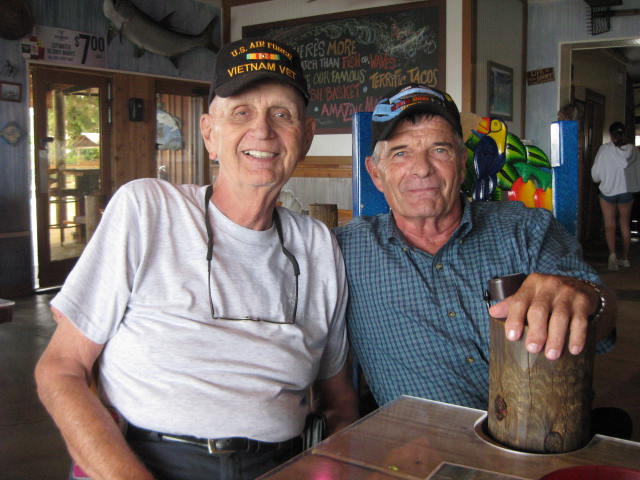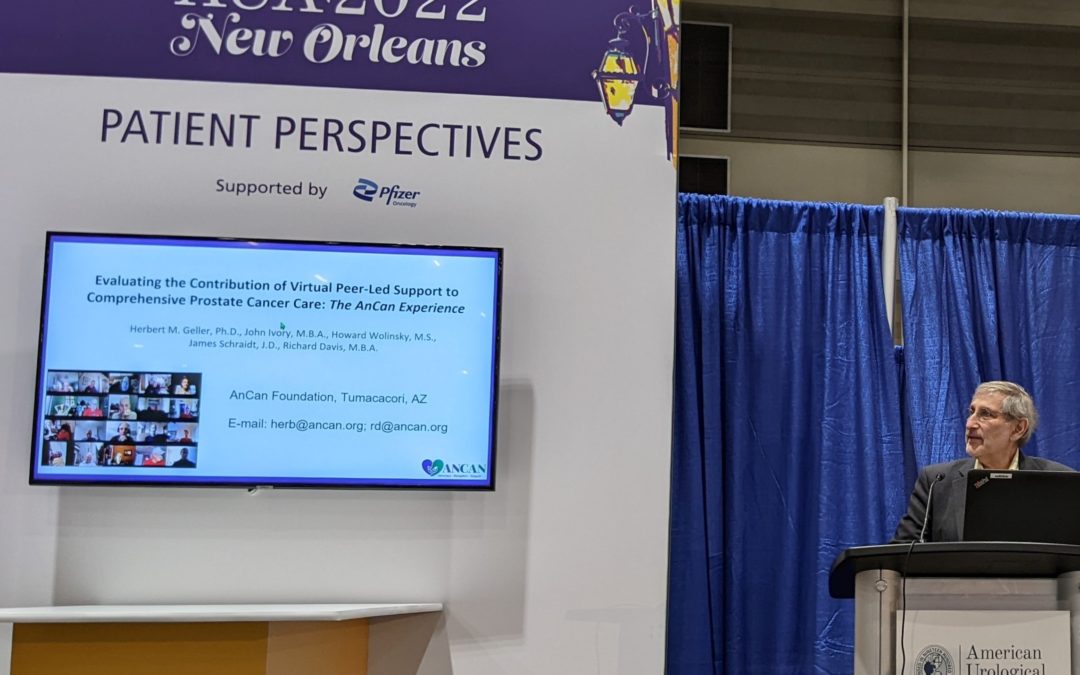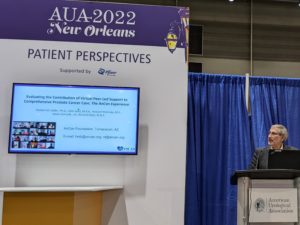
by Jackie Zimmerman | Jan 24, 2023 | Active Surveillance PCa, Book Review, mCRPC, mHSPC, Prostate Cancer, Recent News, Webinars
Invasion of the Prostate Snatchers: An Essential Guide to Managing ProstateCancer for Patients and Their Families by Mark Scholz, MD & Ralph H. Blum
(Other Press, New York; August 2021)
 Summary: “Invasion of the Prostate Snatchers” is a guidebook for prostate cancer patients and their partners. It is of great interest to patients with low-risk to favorable intermediate-risk cancers considering early disease Active Surveillance (AS) since it critically evaluates types of treatment. AS is close monitoring of lower-risk prostate cancers. A patient with prostate cancer (Blum) and a medical oncologist (Scholz) present information patients can use in making key decisions in their care throughout the prostate cancer disease path.
Summary: “Invasion of the Prostate Snatchers” is a guidebook for prostate cancer patients and their partners. It is of great interest to patients with low-risk to favorable intermediate-risk cancers considering early disease Active Surveillance (AS) since it critically evaluates types of treatment. AS is close monitoring of lower-risk prostate cancers. A patient with prostate cancer (Blum) and a medical oncologist (Scholz) present information patients can use in making key decisions in their care throughout the prostate cancer disease path.
My experience: This book was a just-in-time godsend for me. It was released in August 2010. I was in a holding pattern awaiting a follow-up biopsy at that time.I wasn’t diagnosed until Dec. 4, 2010. My cousin, Maxim Schrogin in Berkeley, California, who was diagnosed in January of that year and was on AS, told me the next day that the first thing I needed to do was get this book. I had it in hand within minutes via Kindle. I devoured “Prostate Snatchers” as I prepared for a second opinion on what, if anything, to do about this cancer.
I went against my first urologist’s advice to go on AS and avoid the side effects of active treatment because AS was not the mainstream approach then. My first urologist tried to rush me into the OR though I only had a single core of less than a millimeter of very low-risk Gleason 6 cancer. That’s the lowest level of prostate cancer,
What I liked about the book: This book helped give me the courage to consider AS and go off the then unbeaten path. It helped prepare me to see Scott Eggener, MD, at the University of Chicago, he told me I didn’t need surgery and was “the poster boy for AS.” A new edition of the book, which came out in August 2021, covers these changes and more. The world has changed since 2010 as reflected in the new edition.” Now,,
multiparametric MRIs have been accepted as the first step when PSAs rise, followed by targeted biopsies. The interval between biopsies is generally longer. Genetic and genomic testing has become more common in the U.S. to help determine whether biopsies are needed and which cancers are likely to become aggressive.
Authors Ralph and Mark plus my wife Judi and cousin Maxim were my “support group” as I became an “active surveillor.” There were no support groups devoted to AS then. I would not meet another patient on AS for seven years. We now have support and educational groups devoted to AS, including those from AnCan and Active Surveillance Patients International.
AS patients are not so rare anymore. We now make up the majority of low-risk patients.
Tips from the book: The book is chock full of background on prostate cancer and actionable information. For example, Scholz weighs in on prostate-specific antigen blood testing: “A PSA is considered a ‘cancer test.’ One savvy patient’s advice is to think of PSA as a nonspecific indicator, like the ‘check engine’ light on your dashboard. An elevated PSA may be due to harmless inflammation, recent sexual activity or even a laboratory error. The first step toward investigating the cause of a high PSA is to repeat the test. If the PSA remains high, the next item to consider is that the prostate may be enlarged (BPH).” The authors point out that if PSA is rising, patients should consider multiparametric MRI and targeted biopsy. Back in 2010, those weren’t quite on the table for discussion.
Nitpicks: No book is perfect. The authors, I think, missed an important discussion on the pros and cons of transperineal vs. transrectal biopsies. Transrectal biopsies can lead to sepsis or other
infections and can miss certain areas in the prostate that may harbor cancers. Also, the authors stressed that patients should seek out MRIs with 3-Tesla magnets. To get into the weeds, some new models with 1.5-Tesla magnets can work just as well and are used routinely at the National Cancer Institute. Discuss these matters with your doctor.

In conclusion: “The Invasion of the Prostate Snatchers” provides a critical look at the prostate cancer “industry” and serves as a bible for newbies considering AS and a reminder to those of us who have been on AS for many years of just why we took the now mainstream approach to low-risk prostate cancer. You can live with these “lame” cancers and not die from them. But you need to maintain
surveillance to detect if your cancer is becoming more aggressive.
Reviewed by Howard Wolinsky, editor of TheActiveSurveillor.com and AnCan moderator

by Rick Davis | Dec 4, 2022 | Active Surveillance PCa, Cancer Caregivers, mCRPC, mHSPC, nmCRPC, Prostate Cancer, Recent News, Volunteers
AnCan Vets Meet Up in Florida
AnCan can’t say this enough times … nothing gives us more pleasure than when our Peeps meet up. Our survey last year found that some 35% of our participants make new and lasting friendships outside our groups. That’s our gift to you as well as to ourselves!
Late last month two of our sterling Volunteers met up. Capt. Jim Marshall (USAF) headed south from Alexandria, Virginia to spend a month in Melbourne, Florida, home of our Active Surveillance Prostate Cancr Moderator, Garry Tosca. Here’s what Captain Jim had to say about their lunch meeting:
 During my visit down in the Melbourne, FL area in November I got to meet up with fellow AnCan Vet, Garry Tosca and his lovely partner, Trish, for lunch on the edge of the Indian River at the Old Fish House. Both of us are Vietnam Vets where my time was spent in Saigon at Tan Son Nhut Air Base in Computer Operations.
During my visit down in the Melbourne, FL area in November I got to meet up with fellow AnCan Vet, Garry Tosca and his lovely partner, Trish, for lunch on the edge of the Indian River at the Old Fish House. Both of us are Vietnam Vets where my time was spent in Saigon at Tan Son Nhut Air Base in Computer Operations. Garry did less than two years in the Army with just enough time to be in the thick of fighting in numerous locations in Vietnam. He is my hero earning the National Defense Service Medal (received by all of us just for joining or drafted & affectionately known as the “pizza stain,”), Vietnam Service Medal with a couple of Bronze Stars for fighting in Campaigns, Republic of Vietnam Campaign Medal and the prized Bronze Star.
Bronze Star Medal — a highly respected military decoration given to service members who distinguish themselves while engaged in action against a foreign force
I do understand his most coveted award is the Combat infantry Mens Badge.
The Combat Infantryman Badge (CIB) is a United States Army military decoration. The badge is awarded to infantrymen and Special Forces soldiers in the rank of Colonel and below, who fought in active ground combat while assigned as members of either an Infantry or Special Forces unit of brigade size or smaller at any time after 6 December 1941.
I did learn something I had never thought about concerning VA Disability Ratings associated with Prostate Cancer (PC). With me and the StageIV Metastatic PC plus Vietnam, it is an automatic 100% Permanently Disabled Rating; a real no brainer with a minimum of paperwork needed. Garry is on Active Surveillance now for a number of years, is also considered 100% Disabled even though he is Gleason = 6(3+3).
It now makes sense for when a Vet is undergoing treatment, he/she is rated at 100% until some kind of resolution either one way or the other. Therefore documenting in excruciating detail all that happens during Active Surveillance can be shown as undergoing treatment, actually “continual treatment“. Hopefully he will stay at 100% Temporarily Disabled for the duration even if his PC never goes beyond Gleason 6.
I want to thank Garry & Trish for being such gracious hosts and when I return in the Spring, hopefully we can get caught up on things.
Just a reminder that AnCan now runs a
Veterans’ Health Navigation Support Group, attended by both Jim and Garry and expertly moderated by Capt Joe Gallo (USMC). The group includes a vast amount of experience including administrators and physicians who worked in the VA for decades. It can help with everything from ratings and benefits to treatment. We also have folks using TriCare adn Tricare for Life. Sign up to receive a Reminder at
https://ancan.org/contact-us/
by Rick Davis | May 16, 2022 | Active Surveillance PCa, mCRPC, nmCRPC, Press, Prostate Cancer, Recent News
AnCan Goes Live! … at AUA22 in N’awlins

Herb in AnCan’s Glory
Live performances: Many of us have missed them for two long COVID years. New Orleans has especially missed them. And while AnCan may have never missed them, given our virtual model, Herb Geller still rocked a standing-room-only, live crowd at the American Urological Association (AUA) Annual Conference last Friday the 13th (a good omen, in this case).
Herb delivered AnCan’s research, “Evaluating the Contribution of Video Peer-Led Support to Prostate Cancer Patients: The AnCan Experience” as part of the AUAs “Patient Perspectives” program.

John Ivory, Herb Geller & Jim Schraidt
A number of you with prostate cancer will remember helping us by taking one or two online surveys last year, which made this research possible. Parts of this research had already been accepted at two other conferences, the European Society for Medical Oncology (ESMO) and American Society of Clinical Oncology (ASCO). While we were pleased to be recognized by those forums, COVID turned those conferences virtual, and there’s nothing like a live performance. Herb presented our greatest hits combining both the overall survey and our Active Surveilance specific questionnaire.
Survey participants said this about AnCan groups:
- 83% agreed the information is useful
- 67% discussed the information with their care teams
- 61% changed or informed their treatment path or strategy
- 71% found help navigating treatment path or strategy
- 80% became better advocates for themselves
Strikingly, AnCan participants have improved their lifestyle habits:
- 58% improved exercise habits
- 38% improved diets
- 50% reported reduced stress
AnCan helped participants make connections with each other:
- 85% found the groups to be welcoming
- 43% connected with others
- 30% developed friendships with other participants
Among those who attend early diagnosis, low-risk Active Surveillance meetings:
- 68% said that attendance helped them be their own best advocate
- 23% said that attendance informed them of new insights and treatments
AnCan concluded that:
- The AnCan Support Group model increases patient knowledge, positively impacts treatment planning, and promotes lifestyle improvements while providing support to reduce stress, boosts confidence in navigating the disease, and improves quality of life.
- AnCan empowers patients to self-advocate and improve their disease experience. This is integral to optimize physician/patient interactions and improve outcomes.
- We advocate that virtual peer group attendance, based on our model, be included in (National Comprehensive Cancer Network) NCCN treatment recommendations for prostate cancer patients, especially with advanced disease.
If you took part in one of the two surveys, thanks again. And thanks especially to Rick Davis, Herbert M. Geller, James Schraidt, Howard Wolinsky, (and yours truly) for designing the surveys, crunching the data, and developing and presenting the insights from the data.
John Ivory, May 15 2022

 Summary: “Invasion of the Prostate Snatchers” is a guidebook for prostate cancer patients and their partners. It is of great interest to patients with low-risk to favorable intermediate-risk cancers considering early disease Active Surveillance (AS) since it critically evaluates types of treatment. AS is close monitoring of lower-risk prostate cancers. A patient with prostate cancer (Blum) and a medical oncologist (Scholz) present information patients can use in making key decisions in their care throughout the prostate cancer disease path.
Summary: “Invasion of the Prostate Snatchers” is a guidebook for prostate cancer patients and their partners. It is of great interest to patients with low-risk to favorable intermediate-risk cancers considering early disease Active Surveillance (AS) since it critically evaluates types of treatment. AS is close monitoring of lower-risk prostate cancers. A patient with prostate cancer (Blum) and a medical oncologist (Scholz) present information patients can use in making key decisions in their care throughout the prostate cancer disease path.


 During my visit down in the Melbourne, FL area in November I got to meet up with fellow AnCan Vet, Garry Tosca and his lovely partner, Trish, for lunch on the edge of the Indian River at the Old Fish House. Both of us are Vietnam Vets where my time was spent in Saigon at Tan Son Nhut Air Base in Computer Operations.
During my visit down in the Melbourne, FL area in November I got to meet up with fellow AnCan Vet, Garry Tosca and his lovely partner, Trish, for lunch on the edge of the Indian River at the Old Fish House. Both of us are Vietnam Vets where my time was spent in Saigon at Tan Son Nhut Air Base in Computer Operations. 

